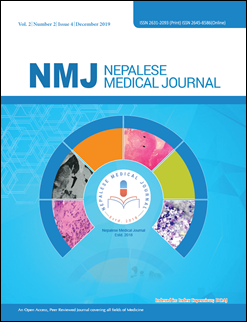Visual Abstracts in Medical Journals
DOI:
https://doi.org/10.3126/nmj.v2i2.26942Keywords:
journal, visual abstract, twitter, social mediaAbstract
Social media, especially Twitter, crept into academic fields and have become a vital part of all the medical fields and journals.1 Medical journals have been increasingly using Twitter to disseminate their contents to attract a wider readership. The Transplantation Journal, that started tweeting from 2015 to “improve engagement with readership and connect with the authors”, showed that the papers that were tweeted were three times more likely to be downloaded than the non-tweeted ones (p<0.001).
Some of the journals started new initiatives to improve their interactions with readers in social media like podcasts, video abstracts and reviews, and Visual Abstracts (VA). VA is a form of graphical abstract used by medical journals. VA was introduced in Annals of Surgery in July 2016.4 Other forms of graphical abstracts in the field of chemistry had appeared as early as 1976. VA is a visual summary of a research manuscript. It consists of a single-page poster that is simple, eye-catching and summarizes the background, methodology, results, and conclusion of the study. These are published or tweeted for improved dissemination of the paper, for deeper engagement of scientists, and to influence busy readers.
Downloads
Downloads
Published
How to Cite
Issue
Section
License
This license enables reusers to distribute, remix, adapt, and build upon the material in any medium or format, so long as attribution is given to the creator. The license allows for commercial use.
Copyright on any article published by Nepalese Medical Journal is retained by the author(s).
Authors grant Nepalese Medical Journal a license to publish the article and identify itself as the original publisher.
Authors also grant any third party the right to use the article freely as long as its integrity is maintained and its original authors, citation details and publisher are identified.




